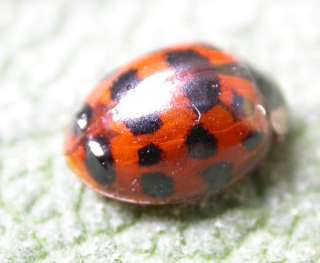%20small%20file.jpg)

Picture © Natural History Museum, London.
Picture G H Green
Worcestershire Record No. 19 November 2005 p. 14
Harry Green
I suggested, in Worcestershire Record No 17 November 2004, that readers should keep a look-out for the Harlequin Ladybird. So far only one has been found in our area although there have been innumerable national reports, especially in SE England. Our one invader was found in Brett Westwood’s garden and reported with colour pictures in the Worcestershire Wildlife Trust newsletter Worcestershire Wildlife News in September 2005, as follows:-
“This large ladybird was first found in the British Isles in 2004 and since then there have been many sightings, mainly in SE England. The species originates from Asia and was introduced into the USA as a possible biological control for aphids. However it is a voracious feeder and if it runs out of aphids it will eat many other insects including the larvae of other ladybirds. There is considerable concern that it will run amok in Britain and damage populations of native species. Nationally a scheme has been launched to collect records of Harlequin Ladybirds and track its progress (or otherwise) through the country. It has already rapidly become a common species in several European countries notably Holland, Germany and France.
So, it is with mixed feelings that we can report the first sighting of a Harlequin in (old) Worcestershire, in Stourbridge on 22nd May 2005. Brett Westwood was insect watching in his garden (see April 2005 Wildlife News) and found a strange ladybird. We were fairly sure it was a Harlequin and sent pictures to the national recording scheme who confirmed our identification. To date (early July) we have not received any more records.
Please look for this ladybird and let Harry Green know of any likely sightings – we should like to see you specimens so please ring the office with a message for Harry if you think you have found one.
How to identify the Harlequin
In size and shape it is quite like the familiar common orange and black 7-spot Ladybird Coccinella 7-punctata. However it is often slightly bigger, rounder and more domed. It occurs in a whole range of colour patterns. A common form is reddish orange with between 15 and 20 black spots. Another form has orange or red spots, and yet another is black with four orange or red spots, and there are many others. The thorax (in front of wing cases) often has large white patches, and the tiny black head a triangular white mark. If you undertake an internet search you will find plenty of information and pictures! British Wildlife journal April 2005 Vol 16, no. 4 page 283 contains useful information.
We look forward to hearing from you.
%20small%20file.jpg) |
 |
| One colour form (orange and black) of Harmonia axyridis Picture © Natural History Museum, London. |
The Stourbridge Harlequin ladybird Harmonia axyridis. Picture G H Green |
Since the previous reports a most useful up-to-date paper has appeared in British Wildlife as referenced below.
References
| GREEN H 2004 The Lily Beetle Lilioceris lilii and the harlequin ladybird Harmonia axyridis: two species worth looking out for. Worcestershire Record 17:26-27. | |
| ROY H, ROWLAND F, BROWN P, WARE R, & MAJERUS M. 2005. Ecology of the
Harlequin Ladybird – a new invasive species. British Wildlife 16, no.
6, pages 403-407 |
| WBRC Home | Worcs Record Listing by Issue | Worcs Record Listing by Subject |